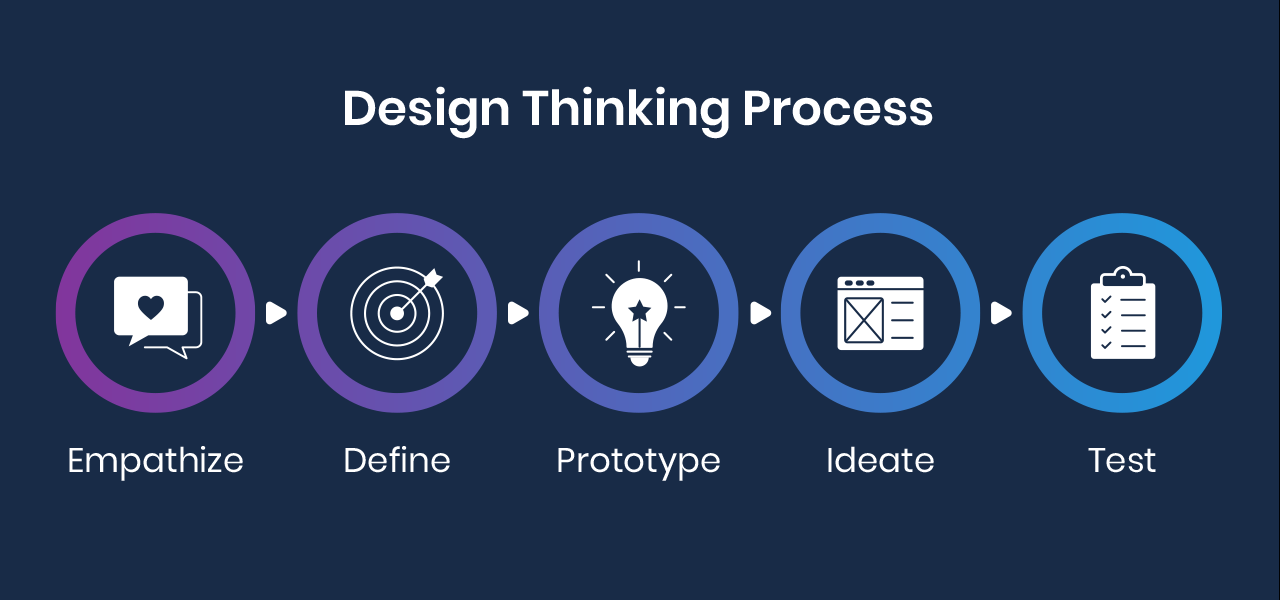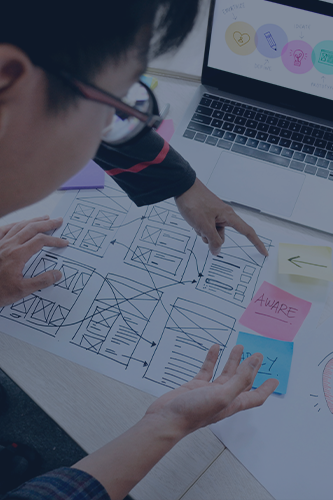The 5 Steps of Design Thinking: A Tech Designer’s Perspective
Techies
The 5 Steps of Design Thinking: A Tech Designer’s Perspective
Creativity and innovation are undoubtedly two of the most essential components to achieving success in today’s constantly evolving digital world.
To stand out from the competition, digital innovative organizations around the globe are now adopting a human-centric approach to their design and development processes.
This approach, referred to as Design Thinking, has been taking the tech design industry by storm as it provides an unparalleled detailed process that can be customized to fit any project.
History of Design Thinking
The origins of Design Thinking date back to the 1950s and 1960s when psychological studies were conducted to define creativity techniques in the architectural and engineering worlds. The 1980s saw the introduction of the human-centric design methodology as an alternative approach to address unique and previously thought unsolvable problems. But it wasn’t until the early 2000s that Design Thinking made its way into the world of services and technology.
Today, tech giants such as Apple and Citrix employ Design Thinking’s innovative techniques to continuously refine their products/services vision. For example, Apple has been constantly introducing user-centered features with every new iteration of their iOS and iPadOS.
This school of thought started with former CEO Steve Jobs’s return to the company in 1997. Back then Apple wanted to shift their focus from fulfilling business needs to catering to actual users’ needs and expectations. Their goal was to release user-friendly, easy-to-use devices that would appeal to a casual audience. In order to achieve that, Apple had to prioritize their design over everything else.
Defining the Design Thinking Process
The Design Thinking process offers design units a set of tools that help solve problems in the most creative and innovative way.
Thanks to its out-of-the-box problem analyzing and solving methodology, tech industry experts often perceive Design Thinking as a philosophy.
While traditionally there have been several linear processes employed by design units to solve problems, Design Thinking is a non-linear process that focuses on the human-centered side of creative problem-solving.
At its core, Design Thinking is the art of figuring out if you are solving the right problem, by empathizing with who you are designing a software/service for.
In fact, while maintaining a designer’s mindset, Design Thinking enables you to approach the problem from the user’s perspective. This also helps in ascertaining if you are solving the right problem. Both the identity and needs of a user can serve as a guidance for devising custom solutions and optimizing the overall design of a software/service.
Design Thinking and Wicked Problems
Design Thinking is often used to address some of the most complex problems in the tech industry, including wicked problems that no traditional method can easily tackle.
Wicked problems, which by nature are hard to identify, can snowball into bigger problems if treated incorrectly.
At first glimpse, the convoluted and perplexing factors of a wicked problem may give the impression that the problem at hand is unsolvable.
But by endorsing creativity, innovation, human-centricity, and divergent thinking, Design Thinking can seamlessly take on the wickedest problems any tech creative team could potentially encounter.
What Are the 5 Steps of Design Thinking?
Design Thinking is divided into five actionable steps that constitute the essence of the process.
While the Design Thinking phases are set in a sequential order, a design team can alter the order to achieve optimum results.
As a matter of fact, if necessary, a single step can be repeated several times during the process.
The five steps of the Design Thinking process are:

Let’s take a closer look at each of the five steps of the Design Thinking process and see how they can impact the workflow of a tech design unit.
1. Empathize: What are the user’s needs?
Empathize is often regarded as the starting point of any design project. In Design Thinking, this step enables the design unit to gain access to a personalized view of the end user’s mindset. In other words, designers put themselves in the user’s shoes to better understand their needs and aspirations.
This crucial step involves human-centric interactions on an emotional and, often, psychological level.
Some of the tools used in the Empathize step are:
- conducting competitive analysis
- conducting interviews
- creating surveys.
2. Define: What problem(s) are we trying to solve?
In Define, tech designers turn the information gathered in the Empathize step into disposable insights to define the real problem statement(s).
At this point, using the obtained data, the design unit should form solid conclusions about the user’s needs and challenges.
This step greatly helps in translating user-related data into a clear and focused direction.
Consequently, this should set the stage for the ideal strategy to be adopted when designing moving forward.
3. Ideate: How do we solve the defined problem(s)?
Ideate marks the beginning of a full-scale solution development phase.
By this stage, the design unit should already have a solid grasp on the challenge at hand so they can initiate the solution creation process. This is the step where all members of a design unit get together and brainstorm, share ideas, throw in suggestions, and eventually narrow down the possibilities until a plan for an optimal solution is found.
Typically, external parties such as stakeholders and actual users join in to elevate the level of confidence in the topics on the table.
4. Prototype: How will the solution look like and function?
In Prototype, designers transform the shortlisted ideas into a tangible representation of how the software/service may look in its final form. In this phase, stakeholders can form a clear visual idea of the solution’s direction, which could pave the way for further input and refinements.
Naturally, creative imperfection may arise during this step. That opens the door for improvement and redesign, which can lead to a series of revisions for the software/service, before committing to the final design.
The results of prototyping usually consist of high-fidelity mockups of the software/service.
The mockups are then transferred to the development team where the software/service gets eventually turned into its final pre-testing form.
5. Testing: Have we done the right thing?
Testing is arguably the most critical step in the Design Thinking process.
It involves user hands-on experience with the product.
Revisiting the data gathered in Empathize may help determine the target test audience here. Throughout the testing phase, users should be able to elaborate on questions such as:
What problem did this software/service solve for you?
How do you rate the user experience?
How does this software/service stand out from other solutions you tried before?
Are there any missing features that you wished were there?
Depending on the results acquired in the Testing phase, the design unit may want to rinse and repeat some of the previous steps until an optimized solution is reached.
Wrapping Up
Design Thinking is an effective problem-solving process that keeps on generating creative and innovative software/service ideas.
By taking the time to :
- understand the challenge at hand
- brainstorm solutions
- develop a prototype
- refine the design
- test the software/service
A tech design unit can consistently come up with unique custom-tailored solutions in any project they undertake.
For a more detailed conversation about Design Thinking and other UX/UI related insights, tune in to Episode 1 of Reimagined.






